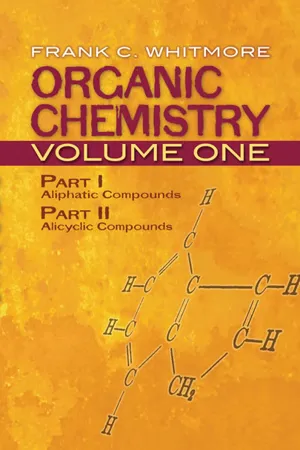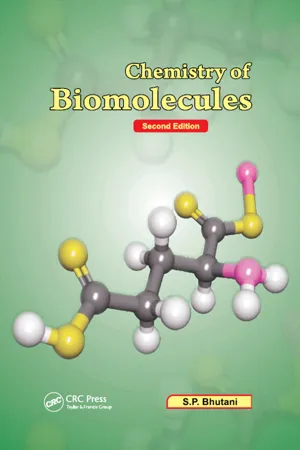Chemistry
Glyceraldehyde
Glyceraldehyde is a simple sugar and an aldose, meaning it contains an aldehyde functional group. It is a three-carbon molecule with a chiral center, existing in two enantiomeric forms: D-glyceraldehyde and L-glyceraldehyde. It is a key intermediate in the glycolysis pathway and serves as a building block for larger carbohydrates.
Written by Perlego with AI-assistance
Related key terms
Related key terms
1 of 4
Related key terms
1 of 3
3 Key excerpts on "Glyceraldehyde"
- eBook - ePub
Organic Chemistry, Volume One
Part I: Aliphatic Compounds Part II: Alicyclic Compounds
- Frank C. Whitmore(Author)
- 2012(Publication Date)
- Dover Publications(Publisher)
A . MONOSACCHARIDESThe simplest sugar, the aldodiose, glycolic aldehyde, has already been described. Its reactions are characteristic of the simple sugars except that the smallness of its molecule causes its dimerization in the reaction of hydroxyl and carbonyl group. It contains no asymmetric carbon atom and, consequently, cannot exist in optically active form as do all natural monoses.Glyceric aldehyde, Glyceraldehyde, propandiolal, HOCH2 CHOHCHO, can be obtained in the racemic forms by the following steps.1566It is interesting that it is probably easier to carry out these steps than to oxidize one of the primary alcohol groups in glycerol although that oxidation has been carried out by hydrogen peroxide and FeSO4 . When the aldehyde is liberated from its acetal, an oily enolic compound is obtained as a by-product, HOCH2 C(OH)=CHOH. Dimolecular Glyceraldehyde boiled with pyridine gives as much as 49% dihydroxyacetone, apparently through this enediol which is common to both substances.1567Glyceraldehyde exists as a crystalline dimer, m. 138°. In solution this gradually changes to the monomer. This behaviour is like that of glycolic aldehyde (p. 331).It acts like a true aldehyde in giving the Angeli-Rimini hydroxamic acid reaction. In this respect it differs from the higher aldoses which show no true aldehyde group in this reaction due to cyclic hemiacetal formation.Its oxime when acetylated and treated with ammoniacal silver solution loses HCN. This is a general method for going from one aldose to the next lower one .1568 The net result is as follows:HOCH2 CHOHCH = NOH → HCN + H2 O + HOCH2 CHOD- and L-Glyceraldehyde have been obtained as syrups. DL-β -Aminolactic aldehyde dimethyl acetal, NH2 CH2 CHOHCH(OMe)2 , was treated with l -menthylisocyanate, C10 H19 NCO, to give substituted ureas,l -C10 H19 NHCONHCH2 CHOHCH(OMe)2 (L)and the L-D isomer. The stereomers were separated and hydrolyzed and the NH2 group was replaced by OH by means of nitrous acid. Hydrolysis by excess of dilute acid gave the optically active Glyceraldehydes.1569 - No longer available |Learn more
MCAT Biochemistry Review 2024-2025
Online + Book
- (Author)
- 2023(Publication Date)
- Kaplan Test Prep(Publisher)
Figure 4.1 .Figure 4.1 GlyceraldehydeThe simplest aldose (an aldotriose)MCAT EXPERTISE
The MCAT likes to present complex, novel molecules and then test you on the most basic information about them. Therefore, when dealing with carbohydrates on the exam, look for the functional groups we have seen before (aldehydes, ketones, and alcohols) and realize that they retain the same chemical properties that you already know.Glyceraldehyde is a polyhydroxylated aldehyde, or as described above, an aldose (aldehyde sugar). The numbering of carbon atoms in a monosaccharide follows the rules described in Chapter 1 of MCAT Organic Chemistry Review. The carbonyl carbon is the most oxidized, and therefore will always have the lowest possible number. In an aldose, the aldehyde carbon will always be carbon number one (C-1). The aldehyde carbon can participate in glycosidic linkages; sugars acting as substituents via this linkage are called glycosyl residues.The simplest ketone sugar (ketose) is dihydroxyacetone, shown in Figure 4.2 . Again, the carbonyl carbon is the most oxidized; in this case, the lowest number it can be assigned is carbon number two (C-2). This is true, in fact, for most ketoses on the MCAT: the carbonyl carbon is C-2. Ketoses can also participate in glycosidic bonds at this carbon. Notice that on every monosaccharide, every carbon other than the carbonyl carbon will carry a hydroxyl group.Figure 4.2 DihydroxyacetoneThe simplest ketose (a ketotriose)Common Names
On the MCAT, a few sugars are tested by referencing their common names, or names that do not necessarily follow the nomenclature rules listed above. You should be familiar with the names of the important monosaccharides listed in Figure 4.3 - eBook - ePub
- S. P. Bhutani(Author)
- 2019(Publication Date)
- CRC Press(Publisher)
i.e., D and L. According to that the Fischer projection is oriented in such a manner so that the most oxidised carbon is on the top. Now if the group of highest priority is on the right it is called D and when this group is on the left, it is called L.So under this convention all monosaccharides with the same configuration at the last chiral carbon atom as D -Glyceraldehyde are called D -sugars. Those with opposite stereochemistry at the last chiral centre are called L -sugars.D-Glyceraldehyde was chosen as an arbitrary standard by Emil Fischer for correlating the configuration of higher sugars. But his guess was later shown to be correct by an X-ray diffraction analysis of the tartarate salts.We can extend the aldose family starting from Glyceraldehyde. As naturally occurring sugars generally belong to the D -family, so we will consider here only those belonging to the D -series, although there are an equal number of enantiomers for each class belonging to the L -series (Fig. 1.5).B. Aldotetroses
D -Glyceraldehyde may be stepped up to give two isomeric tetroses (2 and 3) called D -erythrose and D -threose. They have the same configuration about the last chiral carbon as does D -Glyceraldehyde. The question remains- How to decide the configuration of the generated carbon atom or which is which?This is decided by oxidising the two tetroses to the corresponding dicarboxylic acids and determining the optical rotation of these acids. Thus, on oxidation D -erythrose forms meso-tartaric acid; so its configuration must be (2). On the other hand, D
Index pages curate the most relevant extracts from our library of academic textbooks. They’ve been created using an in-house natural language model (NLM), each adding context and meaning to key research topics.
Explore more topic indexes
Explore more topic indexes
1 of 6
Explore more topic indexes
1 of 4


